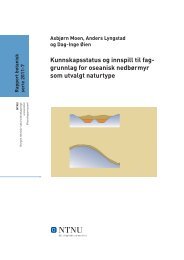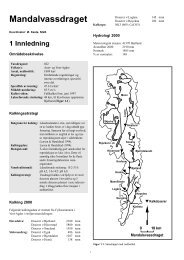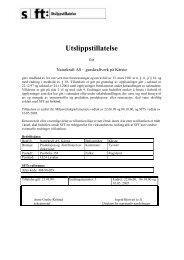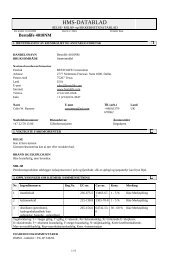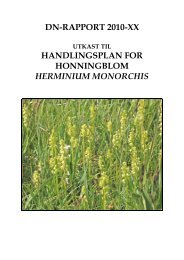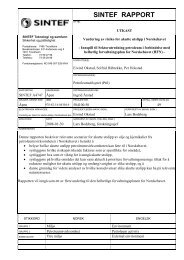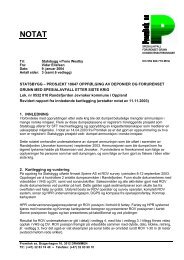Last ned - Direktoratet for naturforvaltning
Last ned - Direktoratet for naturforvaltning
Last ned - Direktoratet for naturforvaltning
You also want an ePaper? Increase the reach of your titles
YUMPU automatically turns print PDFs into web optimized ePapers that Google loves.
Klimaendringer, hav<strong>for</strong>suring og langtransportert <strong>for</strong>urensning<br />
Ocean acidification<br />
Carbon dioxide concentrations both in the atmosphere and in the oceans have risen due to<br />
anthropogenic greenhouse gas emissions. As a result, the average pH of ocean surface water is now<br />
about 0.1 pH units lower than the pre-industrial level. It is estimated that pH may drop by almost 0.4<br />
units in Norway’s sea areas in the period up to 2100, although no modelling studies have been<br />
carried out in the Norwegian part of the North Sea and Skagerrak. Monitoring of acidification in the<br />
North Sea has recently been started, and the results so far show large diurnal and seasonal variations<br />
caused by biological activity.<br />
Five pressures and impacts have been defi<strong>ned</strong> <strong>for</strong> ocean acidification. Changes in pH and the carbon<br />
system are expected to have the greatest effects on ecosystem components. These changes may<br />
result in lower saturation levels of calcium minerals that organisms such as diatoms, crustaceans,<br />
molluscs and corals use to build calcium shells and skeletons. Food supplies <strong>for</strong> other organisms<br />
could be affected as a result, with repercussions along food chains. Lower pH in itself may also have<br />
direct effects on certain ecosystem components.<br />
There is also concern about whether ocean acidification may result in changes in the nutrient and<br />
organic material content of seawater, <strong>for</strong> example by affecting the nitrogen cycle. It could also result<br />
in changes in the bioavailability of micronutrients. The future effects of these two factors are<br />
assessed as moderate and minor respectively, but the knowledge base is very inadequate.<br />
Ocean acidification could also result in changes in the transport, mobilisation and metabolism of<br />
hazardous substances. The very limited knowledge we have at present makes it impossible to draw<br />
any conclusions about the effects on the ecosystem components that have been assessed.<br />
The final factor considered was a decrease in low-frequency ocean sound absorption. The assessment<br />
concluded that this will have no effect in the management plan area.<br />
It is expected that ocean acidification will have major cumulative effects in the management plan<br />
area in the future.<br />
Long-range pollution<br />
The cumulative effects of long-range pollution have been assessed both <strong>for</strong> the current situation and<br />
<strong>for</strong> the two scenarios <strong>for</strong> 2030, with most emphasis on the current situation.<br />
Four different pressures and impacts have been defi<strong>ned</strong> under the theme of long-range pollution.<br />
Long-range transport of hazardous substances (excluding radioactivity) is the factor that is assessed<br />
to have the greatest effect in the management plan area today. Pollution levels are generally low in<br />
the North Sea and Skagerrak, but higher than in the Norwegian and Barents Seas. The content of<br />
hazardous substances in sediments is low, but somewhat higher near the coast. Levels in biota are<br />
also low, but show wider geographical variation and variation between species, sampling media and<br />
pollutants. However, since many of the pollutants in question are bioaccumulative, they may be<br />
present at relatively high levels in species at the top of food chains. It is of particular concern that<br />
levels of dioxins and dioxin-like PCBs in the liver of a large proportion of the gadids sampled in the<br />
open sea exceeded the maximum levels permitted in foodstuffs. Moreover, levels of mercury in cod<br />
Side 9 av 172



